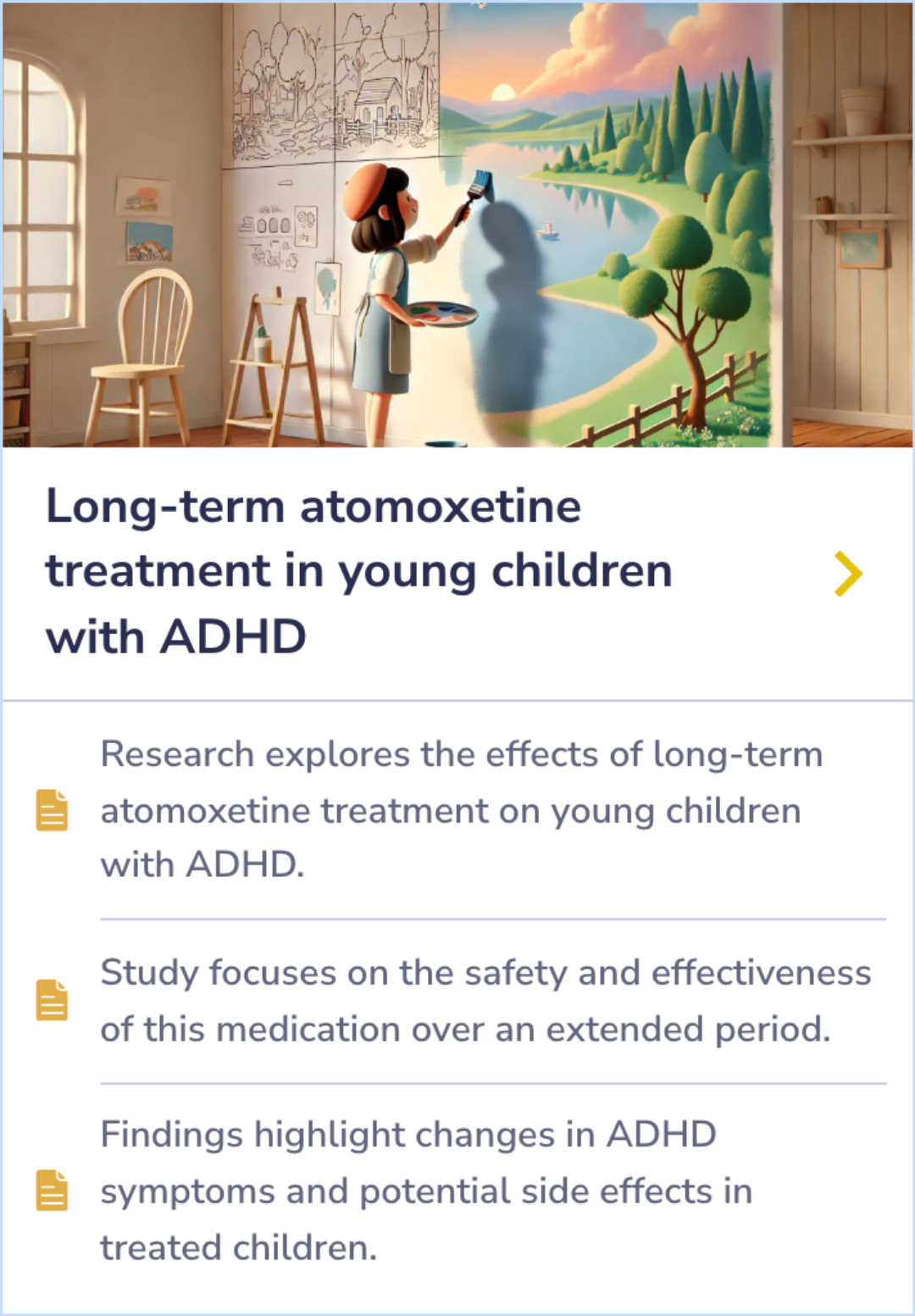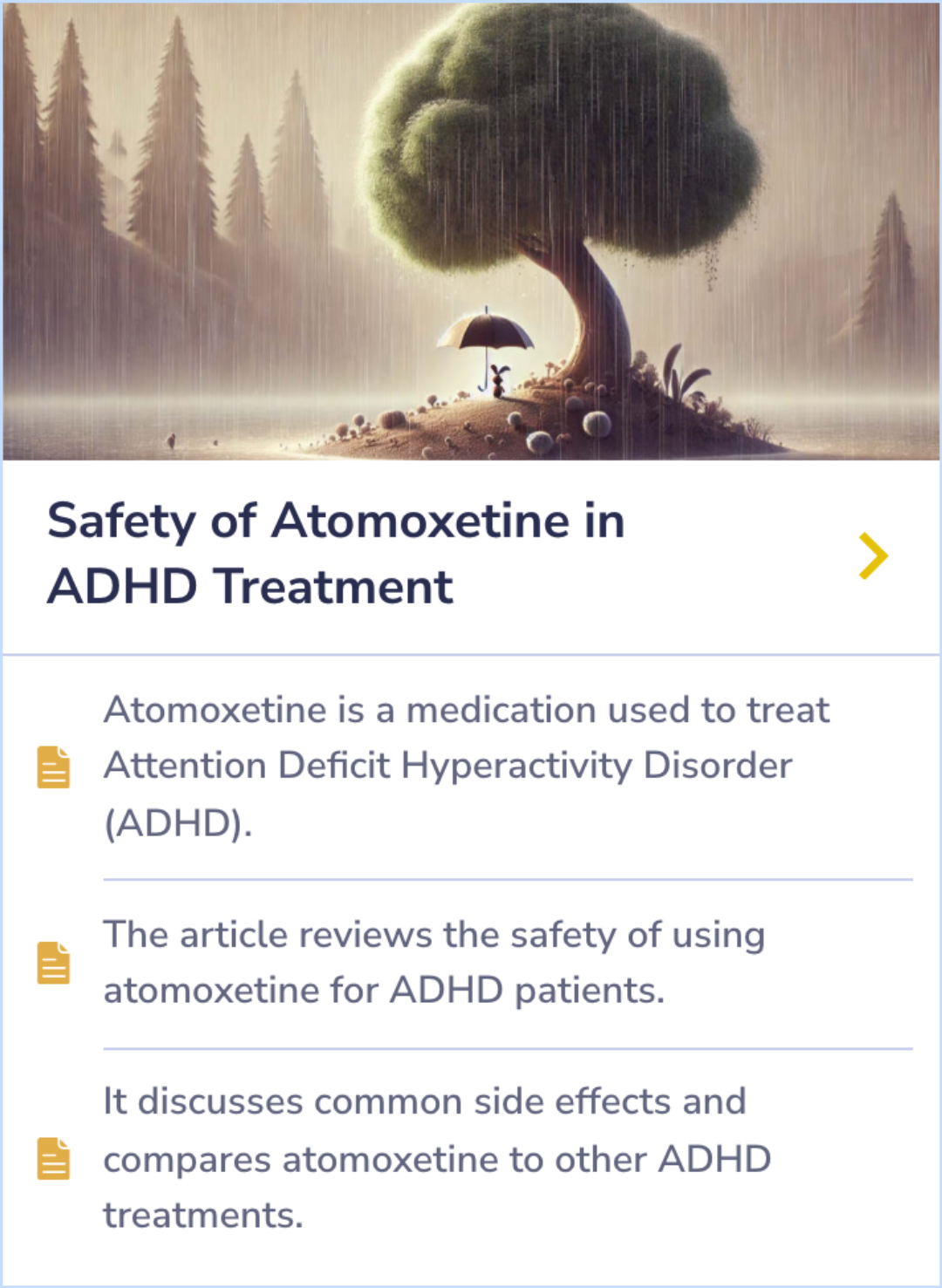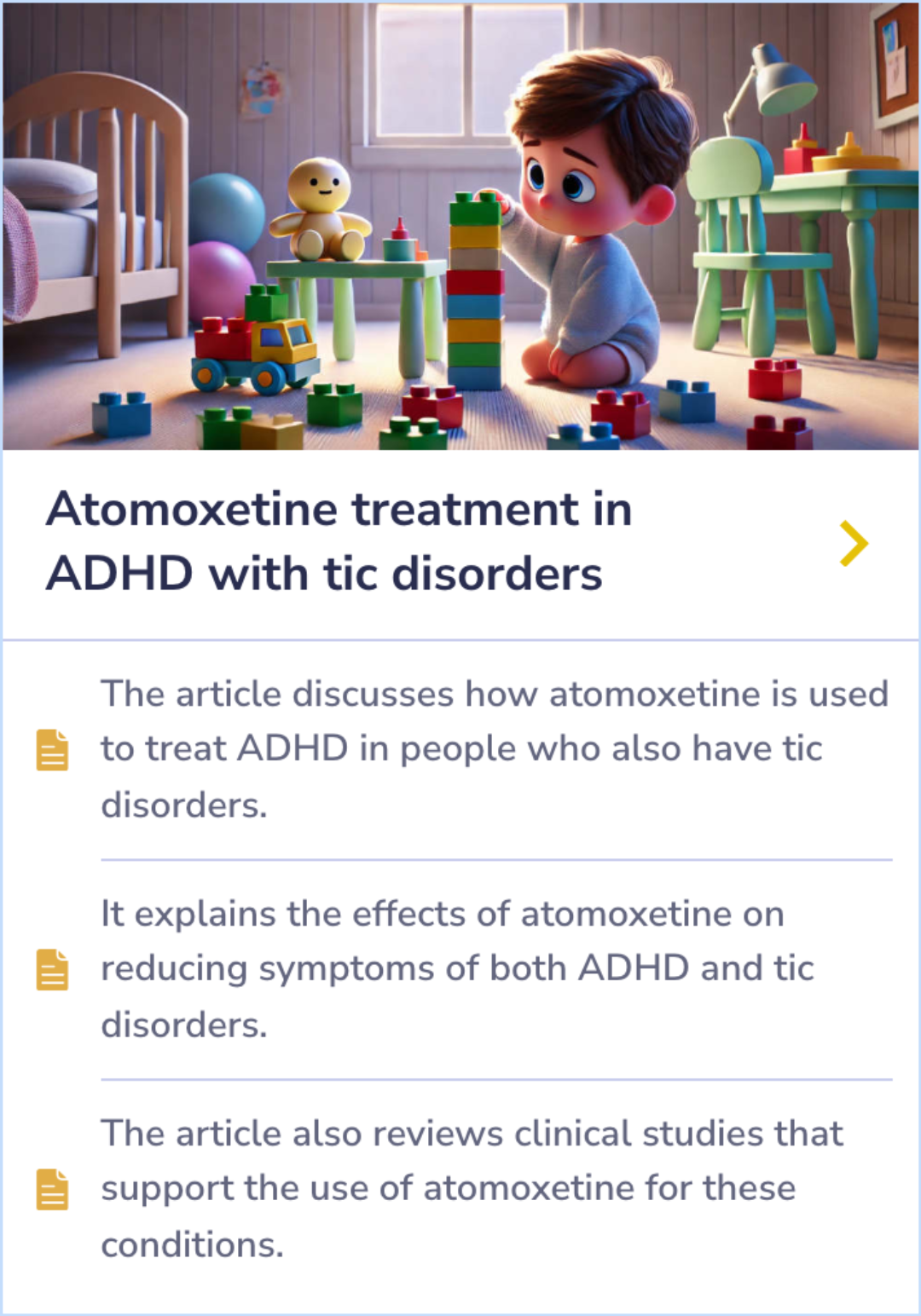Strattera
Evidence Based Answers
3 Studies on the Long Term Effects of Strattera (atomoxetine)
Studies Summary
📈
Monitoring Behavioral Changes with Long-Term Strattera Use
Regular check-ins to monitor mood and actions are key when a child starts or adjusts their Strattera dose, to catch any negative effects early.
📏
Growth and Development Considerations with Strattera
Initial slower growth in weight and height is common in children taking Strattera, but they typically return to near-normal patterns after a year.
📚
Assessing the Long-Term Effectiveness of Strattera
Studies show Strattera provides symptom relief for ADHD for at least 12 months and is well-tolerated by many children over extended periods.
Highly Cited Studies
Long term Effects of Methylphenidate in Adults
Peer Reviewed Study 1
Long-term Strattera Treatment Shows Stable Efficacy and Safety in Adolescents
Peer Reviewed Study 2
Long-Term Strattera Treatment Shows Lasting Effectiveness in Children
Peer Reviewed Study 3
Long-Term Safety of Strattera in Children with ADHD
Personal Experiences
Perspectives: Diverse Experiences with Strattera Long Term
In discussions on the long-term effects of Strattera, people share a range of experiences. Some find it life-changing, improving focus and daily routines, while others highlight side effects like dry mouth and anxiety. Some emphasize the importance of intermittent breaks to avoid tolerance.
There’s also a recognition that satisfied users may be less vocal online, skewing the discussion toward more negative experiences.
There’s also a recognition that satisfied users may be less vocal online, skewing the discussion toward more negative experiences.
Reddit: u/c8linchicca
I’ve been using it for about two years, up to 80mg/day and feel like my life has improved for the better so much... Even just the fact that I can brush my teeth 2x a day and wash my face every morning for the first time in my life is a win for me.Background: Balancing the Risks and Benefits of Strattera
Strattera offers a non-stimulant option for ADHD treatment, which may be appealing for those concerned about stimulant side effects or potential for abuse.
However, it comes with its own risks, such as a slightly increased chance of suicidal thoughts in children, so careful monitoring is necessary.
However, it comes with its own risks, such as a slightly increased chance of suicidal thoughts in children, so careful monitoring is necessary.
“
Source Quotes:
Children and teenagers with attention-deficit hyperactivity disorder (ADHD) who take atomoxetine are more likely to think about killing themselves than children and teenagers with ADHD who do not take atomoxetine.
Atomoxetine is less effective than stimulants but well tolerated.
Background: Evaluating Strattera's Long-Term Effectiveness
Strattera has been found to provide symptom relief for ADHD over long periods, although it may not be as effective as stimulant medications.
Research suggests that it continues to be beneficial and well-tolerated for at least 12 months.
Research suggests that it continues to be beneficial and well-tolerated for at least 12 months.
“
Source Quotes:
Systematic reviews have found few high-quality studies assessing the long-term effectiveness of treatment with stimulants or atomoxetine. Nonetheless, one concluded that medications continue to be effective and well-tolerated over at least 12 months.
Background: Impact of Strattera on Growth and Development
Strattera may affect a child's growth, particularly in the first year of treatment, often leading to slower growth initially.
Monitoring growth patterns is advised as most children return to near-normal growth over time, though they might remain slightly shorter or lighter than expected.
Monitoring growth patterns is advised as most children return to near-normal growth over time, though they might remain slightly shorter or lighter than expected.
“
Source Quotes:
In general, the weight and height gain of pediatric patients treated with STRATTERA lags behind that predicted by normative population data for about the first 9-12 months of treatment.
After about 12 months, gain in height stabilizes, and at 3 years, patients treated with STRATTERA have gained 10.4 cm on average, 0.4 cm less than predicted by their baseline data.
Peer Reviewed Study
Study: Long-term Strattera Treatment Shows Stable Efficacy and Safety in Adolescents
This study looked at the safety and effectiveness of Strattera in adolescents with ADHD over a 2-year period. Among 601 subjects, nearly 90% completed 3 months of treatment, and about half continued treatment for 2 years. The study found significant improvement in ADHD symptoms during the first 3 months, which remained stable for up to 24 months without increasing the dose.
Additionally, no new safety concerns were observed, and there were no major changes in height, weight, or vital signs. A small percentage of subjects discontinued treatment due to lack of effectiveness or side effects.
Additionally, no new safety concerns were observed, and there were no major changes in height, weight, or vital signs. A small percentage of subjects discontinued treatment due to lack of effectiveness or side effects.
author
Wilens TE, Newcorn JH, Kratochvil CJ, Gao H, Thomason CK, Rogers AK, Feldman PD, Levine LR
journal
J Pediatr
Date Published
2006 Jul
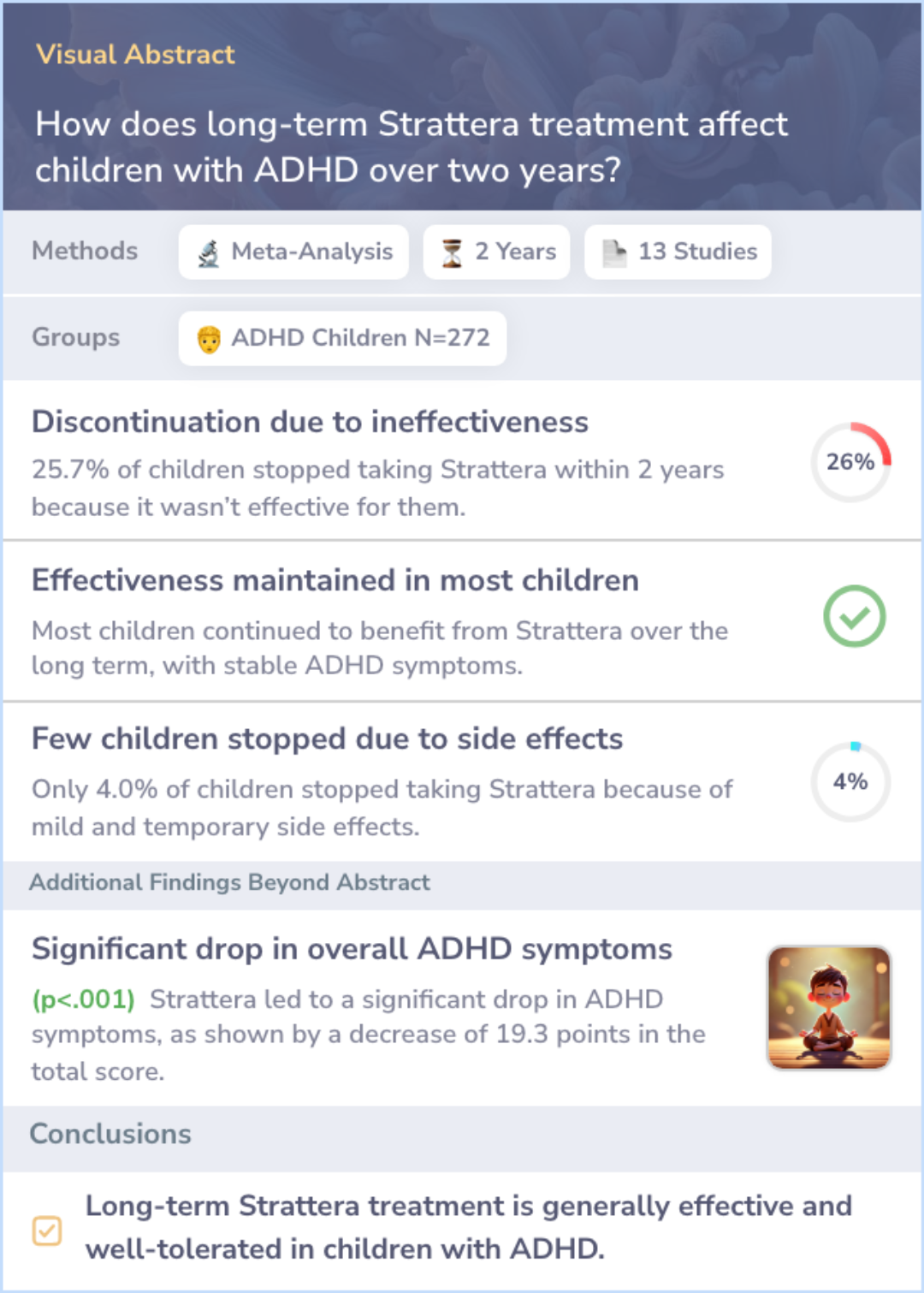
Peer Reviewed Study
Study: Long-Term Strattera Treatment Shows Lasting Effectiveness in Children
This meta-analysis combined data from 13 studies to examine the long-term effects of Strattera on children with ADHD. The study included 272 children, ages 6 and 7, who were treated for at least two years. Effectiveness was generally maintained over time, though 25.7% stopped treatment due to a lack of effectiveness. Most side effects were minor and temporary, with only 4.0% discontinuing due to adverse events. Changes in growth were noted early on but lessened by the two-year mark. While some changes in vital signs were statistically significant, they were not considered clinically meaningful.
Overall, the findings support the idea that long-term Strattera treatment can be effective and well-tolerated in young children with ADHD.
Overall, the findings support the idea that long-term Strattera treatment can be effective and well-tolerated in young children with ADHD.
author
Kratochvil CJ, Wilens TE, Greenhill LL, Gao H, Baker KD, Feldman PD, Gelowitz DL
journal
J Am Acad Child Adolesc Psychiatry
Date Published
2006 Aug

Peer Reviewed Study
Study: Long-Term Safety of Strattera in Children with ADHD
This abstract reviews the safety of Strattera (atomoxetine) in children with ADHD, focusing on seven major safety concerns. Key findings include rare instances of suicidality, aggression, psychosis, seizures, and liver injuries, with no strong associations found. Cardiovascular effects were mostly modest, with minimal long-term impact. Growth reductions were observed but appeared reversible over time.
The data is drawn from various clinical trials, reports, and product guidelines, emphasizing the long-term safety profile of Strattera in children.
The data is drawn from various clinical trials, reports, and product guidelines, emphasizing the long-term safety profile of Strattera in children.
author
Reed VA, Buitelaar JK, Anand E, Day KA, Treuer T, Upadhyaya HP, Coghill DR, Kryzhanovskaya LA, Savill NC
journal
CNS Drugs
Date Published
2016 Jul

Key Takeaways
Conclusions
Long-term Strattera use in children has been shown to offer sustained benefits for managing ADHD symptoms, although it may not be as effective as stimulant medications.
Research indicates that while Strattera can remain effective for at least 12 months, regular monitoring is necessary to manage any behavioral changes, growth considerations, and potential risks such as suicidal thoughts.
Balancing these factors helps ensure that Strattera remains a viable non-stimulant alternative for long-term ADHD management in children.
Research indicates that while Strattera can remain effective for at least 12 months, regular monitoring is necessary to manage any behavioral changes, growth considerations, and potential risks such as suicidal thoughts.
Balancing these factors helps ensure that Strattera remains a viable non-stimulant alternative for long-term ADHD management in children.
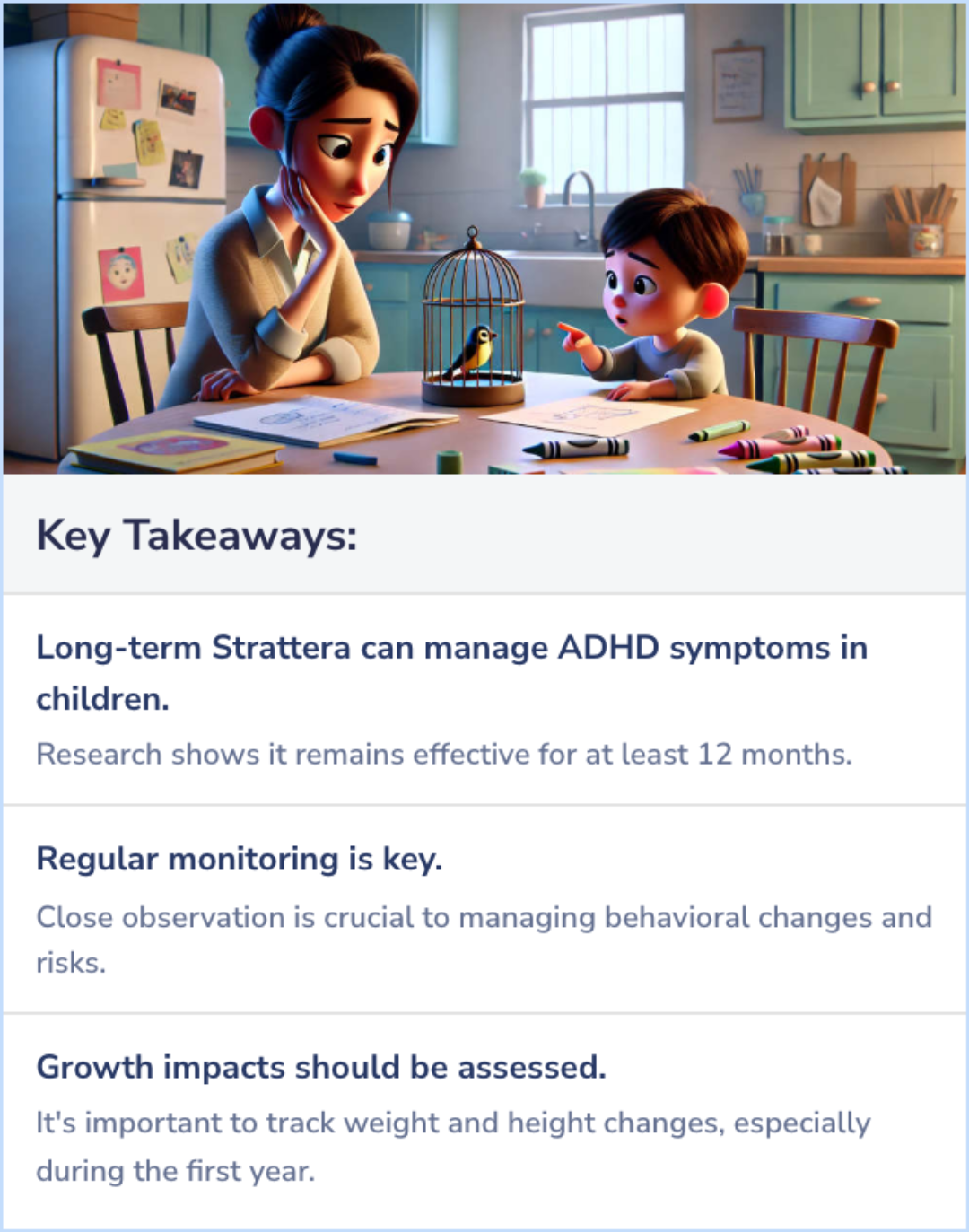
Evidence Summary
Evaluating Long-Term Atomoxetine Use in ADHD-Affected Children
The study assesses how long-term atomoxetine treatment affects young children with ADHD, tracking both the medication's safety and effectiveness. Researchers observed changes in ADHD symptoms and potential side effects over an extended period.
The article highlights the dual focus on monitoring symptom progression and identifying any side effects that might arise during the course of treatment, providing a comprehensive look at the drug's overall impact on young patients.
The article highlights the dual focus on monitoring symptom progression and identifying any side effects that might arise during the course of treatment, providing a comprehensive look at the drug's overall impact on young patients.
Evidence Summary
Comparing Atomoxetine's Safety to Other ADHD Medications
Atomoxetine, known for treating ADHD, stands out for its specific safety profile. It details common side effects, providing a comparative view of how it fares against other ADHD treatments. This gives families comprehensive insights when considering their choices.
Atomoxetine's effectiveness and side effects are thoroughly reviewed, clarifying its role among various ADHD medications.
Providing an in-depth look at commonly experienced side effects helps paint a clearer picture for those considering it as a treatment option.
Atomoxetine's effectiveness and side effects are thoroughly reviewed, clarifying its role among various ADHD medications.
Providing an in-depth look at commonly experienced side effects helps paint a clearer picture for those considering it as a treatment option.
Evidence Summary
Atomoxetine: A Dual Solution for ADHD and Tic Disorders
This article explores how atomoxetine can effectively manage ADHD symptoms in patients with tic disorders. It discusses the dual benefits of reducing symptoms associated with both conditions. Insights from multiple clinical studies further validate atomoxetine’s potential as a treatment option.
Unlike similar medications, atomoxetine shows beneficial effects on both ADHD and tic disorders simultaneously, making it a promising choice for those dealing with both issues. These clinical findings support its usage in specific cases where both conditions coexist.
Unlike similar medications, atomoxetine shows beneficial effects on both ADHD and tic disorders simultaneously, making it a promising choice for those dealing with both issues. These clinical findings support its usage in specific cases where both conditions coexist.
